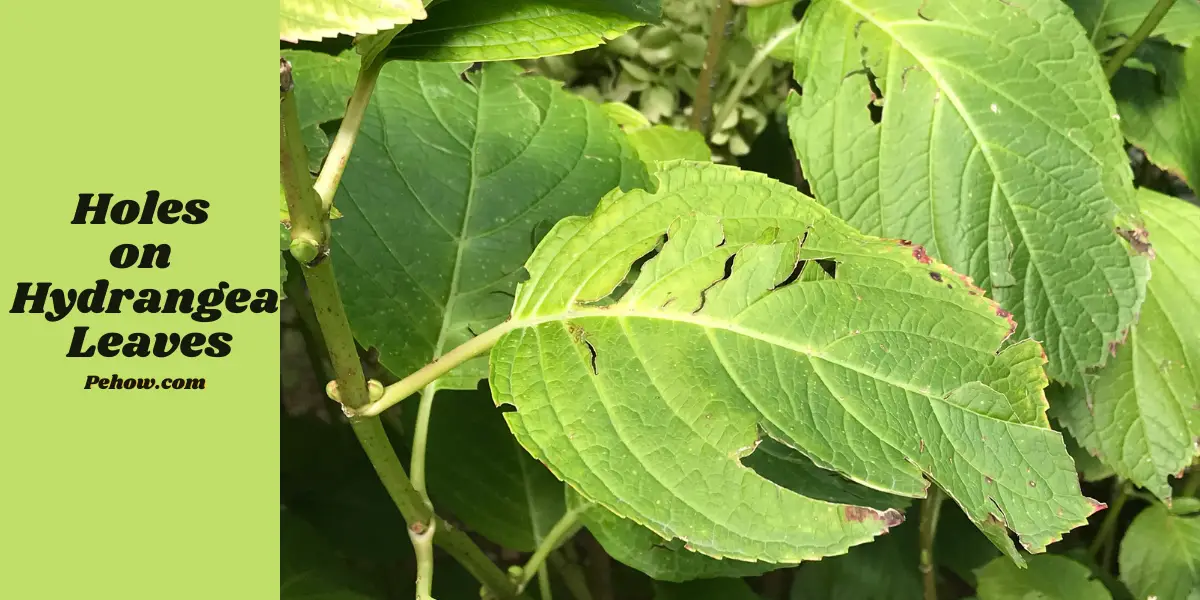Hydrangea leaves can develop holes for a variety of reasons, including damage from insects, disease, or even weather. Holes in the leaves can reduce the plant’s ability to photosynthesize, which can weaken the plant and make it more susceptible to disease. Treatment for leaf damage will depend on the cause of the holes.
Disease can also cause holes in hydrangea leaves. Bacterial and fungal diseases can both cause leaf spots, which can eventually lead to holes. Proper plant care is the best defense against disease, so make sure to water and fertilize regularly. If you do notice disease, be sure to remove any affected leaves and dispose of them properly.
What Causes Holes on Hydrangea Leaves
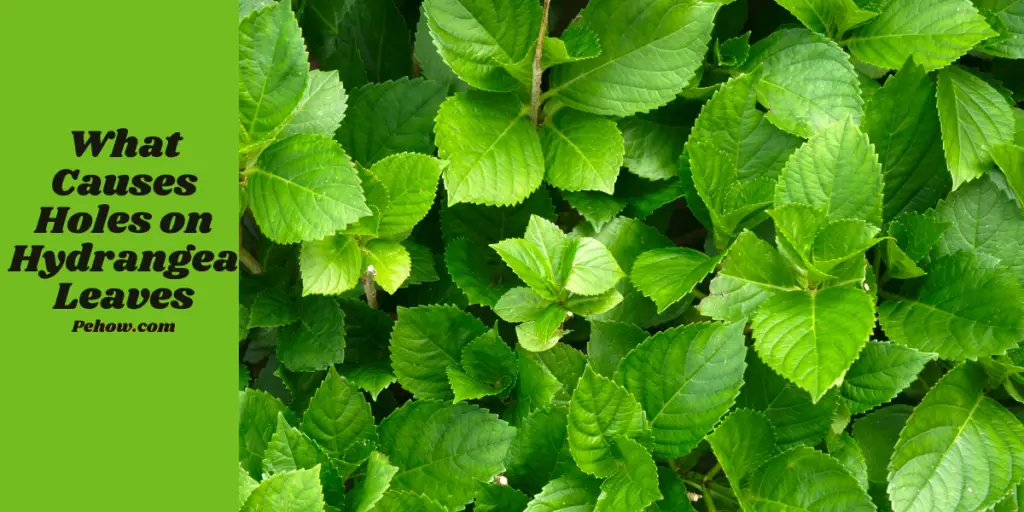
Hydrangeas are a beautiful addition to any garden, but sometimes their leaves can turn brown and develop holes. There are several possible causes of this, including pests, diseases, and nutrient deficiencies. Six types of insects can cause holes in hydrangea leaves.
- Aphids
- Caterpillars
- Japanese Beetles
- Leaf miners
- Slugs
- Thrips
1. Aphids
Aphids are one of the most common pests that can cause holes in hydrangea leaves. They are small, sap-sucking insects that can be difficult to control. They often congregate on the underside of leaves, where they can cause extensive damage.
2. Caterpillars
Caterpillars are the larvae of moths and butterflies. They can cause serious damage to hydrangea leaves, particularly if they are left unchecked. There are several ways to deal with caterpillars, including biological controls, such as parasitic wasps, and chemical controls, such as Bacillus thuringiensis.
3. Japanese Beetles
Japanese beetles are a type of leaf beetle that is native to Japan. They were first introduced to the United States in 1916 and have since become a major pest of hydrangeas. Japanese beetles are most active during the day and are attracted to the flowers of hydrangeas.
Japanese beetles are small, metallic-looking creatures that feast on the leaves of a number of different plants, including hydrangeas. The beetles leave behind telltale holes in the leaves as they feed.
To get rid of Japanese beetles, you’ll need to handpick them from your plants and dispose of them. You can also trap the beetles using a pheromone trap or a homemade trap made from a 2-liter soda bottle.
4. Leaf miners
Leaf miners are tiny insects that tunnel through the leaves of plants, causing damage as they go. They can be difficult to control because they spend most of their lives inside the leaves of plants, where they are protected from insecticides.
5. Slugs
Slugs are a type of snail that lacks a shell. They are common garden pests that can cause serious damage to hydrangea leaves. Slugs are most active at night and are attracted to the flowers of hydrangeas.
6. Thrips
Thrips are a type of tiny, sap-sucking insects that can cause damage to the leaves of hydrangeas. They are most active during the day and are attracted to the flowers of hydrangeas. There are several ways to control thrips, including biological controls, such as parasitic wasps, and chemical controls, such as insecticides.
How can holes be without insects?
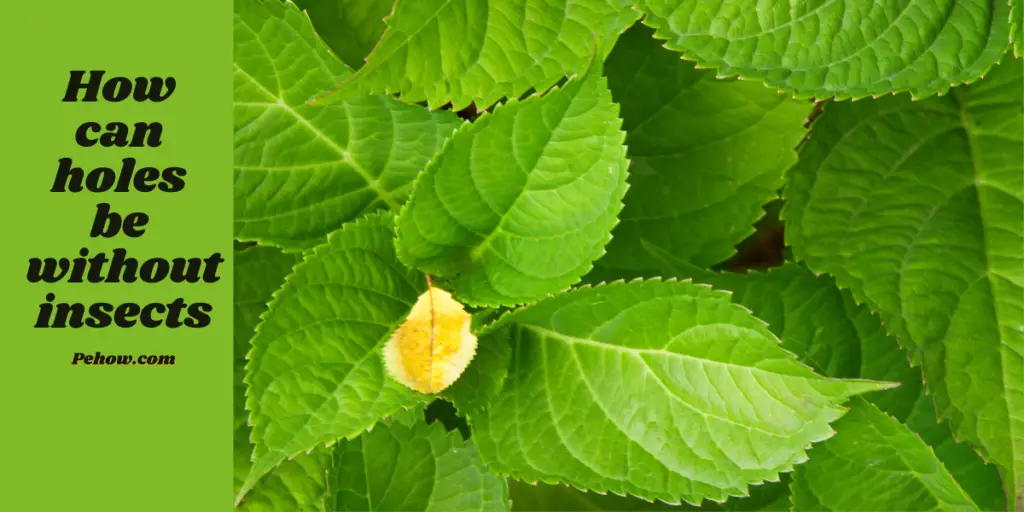
Pests are not the only creatures that can cause holes in hydrangea leaves. Diseases, such as powdery mildew and leaf spot, can also cause holes. Nutrient deficiencies, such as a lack of nitrogen, can also cause leaves to turn brown and develop holes. Holes can also be caused by exposure to cold temperatures or herbicides.
If you see holes in your hydrangea leaves, inspect the plant for pests. If you find any, remove them by hand or use an organic pesticide. You can also try to control powdery mildew and leaf spot by keeping the plant well-watered and avoiding overhead watering.
Fertilize the plant with a nitrogen-rich fertilizer if you suspect a nutrient deficiency. If the plant is exposed to cold temperatures, move it to a warmer location. If you think the holes were caused by herbicides, stop using them and try an organic alternative.
Prevention Tips for Holes on Hydrangea Leaves
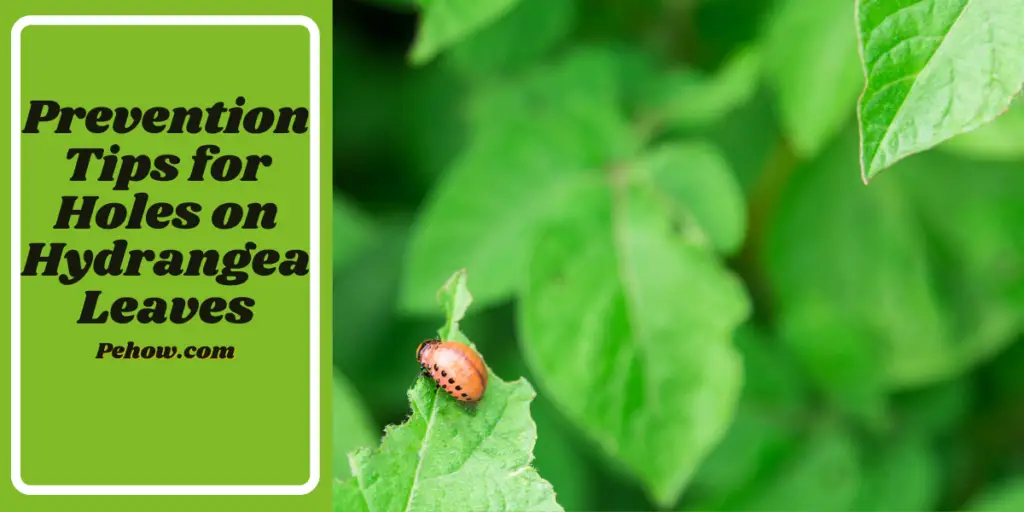
Prevention for hydrangea leaf holes can be very difficult because the pests that cause the holes are very small and difficult to spot. The best prevention method is to keep your garden clean and free of debris. This will help to deter the pests from taking up residence in your garden.
You can also try using a pesticide to keep the pests away. If you do notice holes in your hydrangea leaves, be sure to remove the affected leaves and dispose of them properly. You should also check the rest of your garden for signs of pests and take steps to control them. here are some tips:
1. Keep your garden clean and free of debris
The best way to prevent holes in your hydrangea leaves is to keep your garden clean and free of debris. This will help to deter pests from taking up residence in your garden. Pests always attack more in dirty places because there is more hiding spots and food sources for them. Clean up the garden to reduce insect food sources and hiding spots.
2. Use a pesticide
Pesticide can be used as a preventive measure to keep pests away from your garden. If you notice holes in your hydrangea leaves, be sure to remove the affected leaves and dispose of them properly. You should also check the rest of your garden for signs of pests and take steps to control them.
3. Remove affected leaves
affected leaves should be removed as soon as possible. Holes in the leaves are an indication that pests are present and if left untreated, these pests can spread to other parts of the plant or garden. To remove affected leaves, simply cut them off at the stem and dispose of them properly.
Check the rest of your garden
Once you’ve removed the affected leaves, be sure to check the rest of your garden for signs of pests. If you find any, take steps to control them so they don’t spread to other parts of the garden.
How to Treat Holes on Hydrangea Leaves
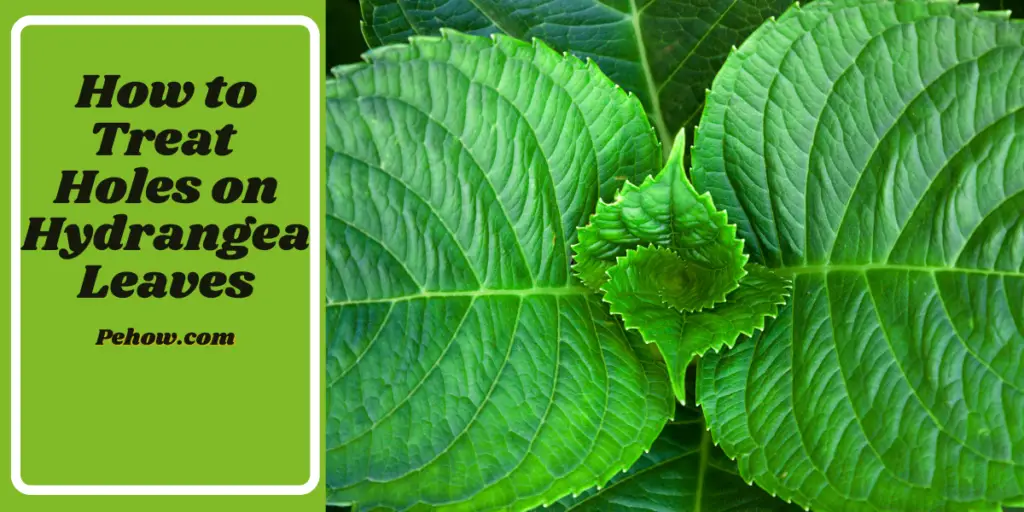
Infected leaves display small, brownish spots that eventually enlarged and turn yellow. Holes then form in the leaf as the tissue dies. If left unchecked, the infection can cause the entire plant to wilt and die. Treating holes on hydrangea leaves requires identifying the underlying cause of the problem and taking appropriate corrective action.
Most often, holes on hydrangea leaves are the result of insect pests. Common culprits include Japanese beetles, leaf miners, and caterpillars. Less frequently, the disease can also cause leaf hole damage. For example, bacterial leaf scorch and fungal diseases like powdery mildew and anthracnose can cause similar symptoms.
To confirm that insect pests are causing the holes in your hydrangea leaves, look for other telltale signs of an infestation. For instance, you may see the insects themselves or their larvae on the plant. You may also notice that the plants are being chewed on or skeletonized. If you suspect that disease is to blame, look for other signs like thinning leaves, discoloration, or spots.
Once you’ve determined that insect pests are the problem, you can take steps to get rid of them. For small infestations, you may be able to simply pick the pests off by hand. You can also use Insecticidal soap or horticultural oil to treat the plant. Be sure to follow the instructions on the label carefully.
For larger infestations or for those that are difficult to control, you may need to use a stronger insecticide. Neem oil is a natural option that is relatively safe for people and pets. You can also use chemical insecticides, but these should be a last resort. Be sure to follow the instructions on the label carefully to avoid harming the plant.
Once you’ve treated the insect pests, take steps to prevent them from returning in the future. Japanese beetles can be controlled with traps, and leaf miners can be controlled with parasitic wasps. You can also keep caterpillars away by avoiding the use of broad-spectrum insecticides, which kill their natural predators.
Disease-causing agents can be more difficult to control. Bacterial leaf scorch, for example, is spread by xylem-feeding insects like leafhoppers. To prevent this disease, avoid overhead watering and water the base of the plant instead.
For powdery mildew and other fungal diseases, practice good hygiene by removing infected leaves and avoiding overcrowding. You can also use a fungicide to prevent or treat these diseases.
Holes in hydrangea leaves can be unsightly and may eventually kill the plant if left untreated. By taking steps to control the underlying cause of the problem, you can prevent further damage and keep your plant healthy.
The Summary
Holes in hydrangea leaves can be caused by insect pests or diseases. To treat the problem, you’ll need to identify the underlying cause and take appropriate corrective action. You can often control small infestations by picking the pests off by hand or using a natural insecticide. For larger infestations, you may need to use a stronger insecticide. You can also take steps to prevent the problem from returning in the future.
To enhance the beauty of your hydrangea foliage and keep the leaves looking their best, start with planting disease-resistant cultivars. Then, provide the necessary care to ensure proper plant health including proper watering, fertilization, and pest control measures. Holes in hydrangea leaves can detract from the plant’s beauty, so it is important to take action to prevent or treat the problem as soon as possible.
So, if you’re noticing holes in your hydrangea leaves, don’t despair. By taking some simple corrective measures, you can soon have your plant looking as good as new. Holes in hydrangea leaves are unsightly but with the right care, you can soon have your plant looking its best. Thanks for reading!


